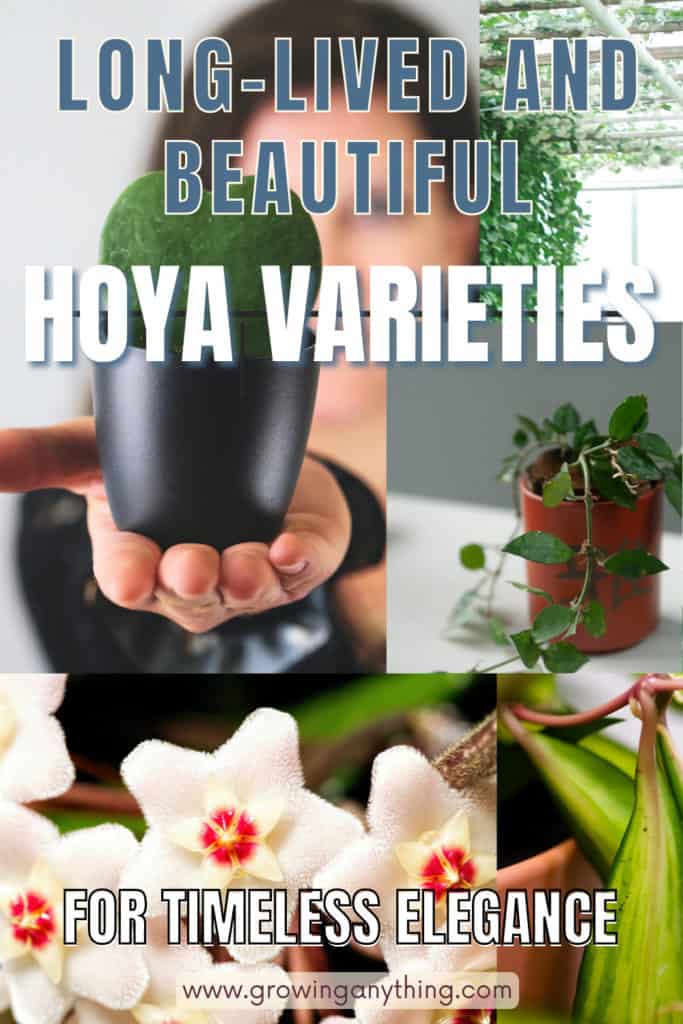57 Hoya Varieties
The majority of Hoya varieties are easy to identify because of the waxy leaves and star-shaped flowers. These stunning plants are praised for their beautiful foliage, striking blooms, and lovely fragrance.
Hoya is often referred to as the Wax plant, and there are numerous Hoya varieties with more or less noticeable differences.
Hoya is native to Australia and Asia, where it grows in and around the trees as vines or bushes. Interestingly, some Hoya plants need cool temperatures to bloom and are better suited for milder climates.
Get ready for a tough decision: pick your favorite Hoya plant from the following list!
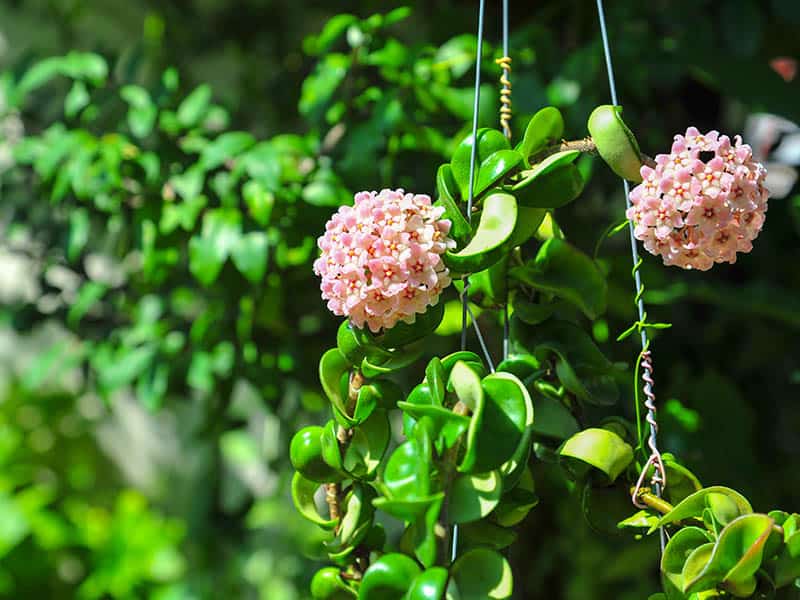
1. Hoya Fitchii
Fitchii Hoya comes from the Philippines and is known for its attractive flower color variations. The blooms can be from yellow, through orange and pearly pink! Overall, Fitchii Hoya isn’t difficult to grow. But, it can be a challenge to find the plant in the nurseries.
2. Hoya Caudata
Hoya Caudata, in its native habitat, Thailand, Singapore, Sumatra, grows as an epiphyte vining plant. The foliage is covered with a waxy texture, and the plant is known under the sweet bloom fragrance.
Position the plant in bright sunlight and keep the temperature between 60 and 95 degrees Fahrenheit. The soil needs to be well-draining and the ideal moisture for Hoya Caudata is above 60%.
3. Hoya Wayetii
Hoya Wayetii features long and thin leaves with red borders. The plant is native to the Philippines, and it is a trailing plant. Before it develops 30 inches long trails, Hoya grows as a mounding plant.
Wayetii Hoya can develop from ten to 20 small flowers during the flowering season. The plant is suitable for outdoor or indoor use and looks stunning in hanging baskets.
4. Hoya Pachyclada
Hoya Pachyclada is one of the Hoya plants with the slowest growth rate. The plant has waxy foliage and develops round clusters of flowers. Each cluster has around 25 tiny, star-shaped flowers.
Pachyclada needs bright, filtered sunlight to thrive, warm temperatures and high humidity.
You can use orchid fertilizer twice a year to boost the growth of the plant.
5. Hoya Bella
Like many other Hoyas, the Bella variety grows on other plants. It is one of the most beautiful and easily accessible Hoya plants. Luckily, it doesn’t require complex care, and it is suitable for beginners.
Bella Hoya comes from Myanmar and likes slightly cooler temperatures. When taking care of Hoya Bella, never let the soil dry completely, between two waterings.
Keep the plant in dappled shade for the best results.
Check how easy to propagate Hoya is.
6. Hoya Retusa
Hoya Retusa is sometimes called Grass Leafed because of the thin and narrow leaves. The plant is the most beautiful during the flowering season when it develops tiny white, star-shaped flowers with dark purple centers.
The white flowers stand out against lush green foliage! Wait for the soil to dry completely between two waterings and keep it under bright, indirect light.
Tips for growing Hoya retusa indoors.
7. Hoya Australis
Hoya Australis is one of the easiest Hoya varieties to grow. The plant is tolerant to mild coldness but needs protection from severe frosts. It has thick and fleshy foliage, like succulents.
The blooms are bright white, so Hoya Australis fits into every interior decor.
You can use fertilizer once a month during the growing season, and provide indirect light.
8. Hoya Lacunosa Eskimo
If you want a highly fragrant houseplant, pick Hoya Lacunosa Eskimo. The plant develops small, white flowers which disperse outstanding fragrance. The fragrance is distinctively sweet, and the flowers may appear year-round.
Additionally, Hoya Lacunosa Eskimo is grown for its ornamental silver-speckled pointy foliage.
9. Hoya Kentiana
The rare Hoya Kentiana plant is an attractive plant, best known for its unique foliage. Some variegated varieties of Hoya Kentiana are speckled with a pink hue on the leaves’ waxy surface, which improves the plant’s beauty.
In its essence, Hoya Kentiana is a succulent plant with an exceptional growth rate. It isn’t difficult to grow because of the medium water and lighting requirements.
10. Hoya Carnosa
Hoya Carnosa is a beautiful indoor plant, best known for its bright flowers. The plant features thick and rich green foliage and needs a lot of sunlight to thrive.
Hoya Carnosa won’t bloom the first year after planting. Most plants need from two to three years to start producing blooms.
11. Hoya Kerrii
Hoya Kerrii enjoys an abundance of bright, filtered light. The plant has moderate water requirements, and you can let the soil dry out completely between two waterings.
However, Hoya Kerrii thrives in rooms with high humidity. You can mist the plant or keep it in a near humidifier. Also, Hoya Kerrii will benefit from monthly fertilization during the growing season.
12. Hoya Obovata
Position the Hoya Obovata in bright, indirect light so the plant can develop to its full potential. Because it is a semi-succulent plant, Hoya Obovata is a drought-tolerant and low-maintenance plant.
Because of it, Obovata is one of the most popular indoor trailing plants, and a perfect housewarming gift!
13. Hoya Pubicalyx
Among plant lovers, Hoya Pubicalyx is praised for its vigorous growth! This no-fuss plant needs minimal care.
It includes an abundance of water, well-drained soil, and medium bright light. You have to prune the plant lightly, in the spring or summer.
14. Hoya Carnosa Compacta
Hoya Carnosa Compacta is sometimes called Hindy Rope Plant and looks best in hanging pots so the trailing vines can showcase!
The plant requires minimal effort to grow and can survive decades in the right conditions.
It needs well-aerated soil, filtered bright light, and plenty of moisture to grow.
15. Hoya Cumingiana
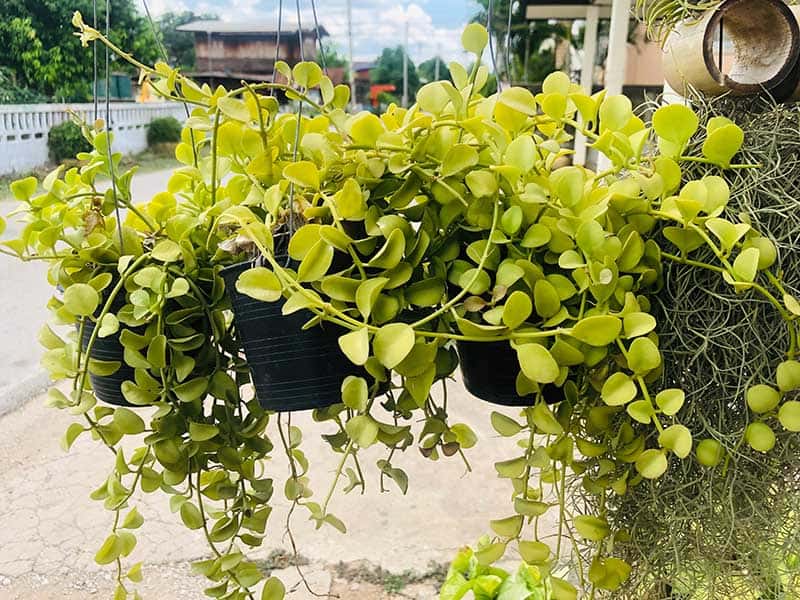
Hoya Cumingiana is a low-maintenance plant, best known for its cinnamon-smelling blooms! You can grow in on the trellis for maximum visual effect, but don’t expect blooms soon after planting. Hoya cumingiana needs approximately two years to start producing flowers!
16. Hoya Serpens
Hoya Serpens or wax-flowering plant is an exotic variety in the Hoya genus. The plant has round foliage and pastel green flowers.
You can grow it in the garden or indoors and enjoy the amazing, mildly fragrant bloom year-round.
It needs well-aerated soil and regular watering.
How not to kill Hoya serpens.
17. Hoya Macrophylla
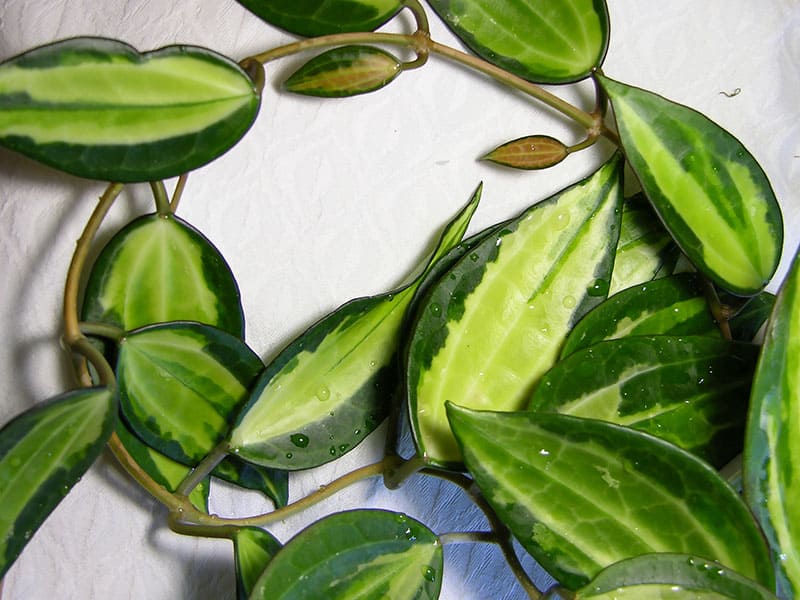
Macrophylla Hoya is another Hoya variety, which grows on top of other plants. The plant features thick and robust foliage with light-yellow edges.
Hoya Macrophylla develops beautiful creamy white flowers with a slight pinkish hue.
The plant can easily thrive indoors. Place the pot away from direct sunlight, and water the plant thoroughly when the soil dries completely.
18. Hoya Shepherdii
Hoya Shepherdii is often called String Bean Hoya. You can identify it because of the small, and heavily fragrant flowers!
The foliage is waxy, and the thick leaves appear on the long vines! Therefore, Hoya Shepherdii looks stunning when potted in a hanging basket.
The plant is adaptable to various conditions but grows best in moderate light and with a lot of water.
19. Hoya Memoria
Hoya Memoria enjoys plenty of water. You can allow the plant to dry between two waterings and then soak it thoroughly in the water.
Soggy soil increases the risk of rotting, and it is the only sure way to kill Hoya Memoria.
It is one of the relatively newly discovered and cultivated Hoya varieties.
20. Hoya Multiflora
Hoya Multiflora is better known under the name Shooting Stars. The plant got the common name because of the charming clusters of white, star-shaped flowers!
Hoya Multiflora flowers have a sweet fragrance. You can distinguish Multiflora Hoya by its bushy, and not trailing growing habit.
Provide moist, well-draining soil and semi-shade for the plant.
21. Hoya Obscura
Obscura Hoya is a low-maintenance plant that prefers well-drained soil, warmth, and high humidity. The watering requirements aren’t much different from other tropical flowers requirements.
The plant needs moderate lighting to develop lush foliage. However, keep the plant away from direct sunlight. Too bright sunlight can burn the leaves.
22. Hoya Pottsii
If you provide warm temperatures and plenty of sunlight, you won’t have any issue growing Hoya Pottsii.
The plant develops beautiful flowers in different colors, from yellow-green to pink. These have a strong fragrance and each plant can develop up to 20 flowers per cluster.
23. Hoya Purpureofusca
Hoya Purpureofusca is a lovely perennial vine with evergreen foliage. The plant looks great year-round and has an extended blooming season. You can expect magnificent flowers to appear in spring, summer, and fall! The bloom color range is from pink to dark purple, hence the name.
Purpureofusca doesn’t need as much water as some other Hoya varieties.
24. Hoya Plicata
You can grow Hoya Plicata outdoors in zones warmer than 10b. In colder zones, you can grow it as a beautiful houseplant.
Hoya Plicata is easy to propagate by stem cuttings.
The plant is easy to care for, and develops distinctive flowers, like most other Hoya varieties.
25. Hoya Neocaledonica
Hoya neocaledonica has been cultivated for over a century. You can grow it from cuttings, and the plant only requires simple care.
Hoya neocaledonica flowers aren’t fragrant like other Hoya blooms. But, they are equally beautiful and even last longer. In most cases, they won’t fall off for around two weeks.
26. Hoya Burtoniae
Hoya Burtoniae is best known for its unique and attractive leaves with a reddish hue around the edges. People often confuse it with a similar plant – Hoya Bilobata. But, the primary difference is in the leaf texture. Bilobata has fuzzy leaves, and Burtoniae Hoya features smooth waxy foliage.
27. Hoya Coronaria
Hoya Coronaria features thick, waxy foliage and develops wonderful flowers. Unfortunately, the flowers only last for several days.
Coronaria Hoya comes from Singapore, Borneo and Thailand. It is an easy-to-grow plant, with good drought and salt tolerance.
28. Hoya Linearis
Hoya Linearis thrives in bright, indirect light. Bright light may cause leaves to turn yellow.
You have to water the plant moderately, but allow the soil to dry between two waterings.
During winter, Hoya Linearis only needs a minimal amount of water.
29. Hoya Meredithii
Hoya Meredithii isn’t as popular as some other Hoya plants. It is most likely because the cuttings aren’t easy to find in the nurseries and the flowers only last for less than five days.
The plant has moderate sunlight requirements, but it likes plenty of water. Reduce the watering frequency in winter to keep the Hoya ready for the new growing season!
30. Hoya Finlaysonii
Keep your Hoya Finlaysonii under bright, filtered light to keep the plant thriving. The plant needs a lot of light, but too much sunlight can burn the foliage. If your Hoya Finlaysonii isn’t blooming, it is a sign that the plant doesn’t receive enough sunlight.
Keep the soil moist and well-drained and increase the humidity in the room as much as possible.
31. Hoya Imperialis
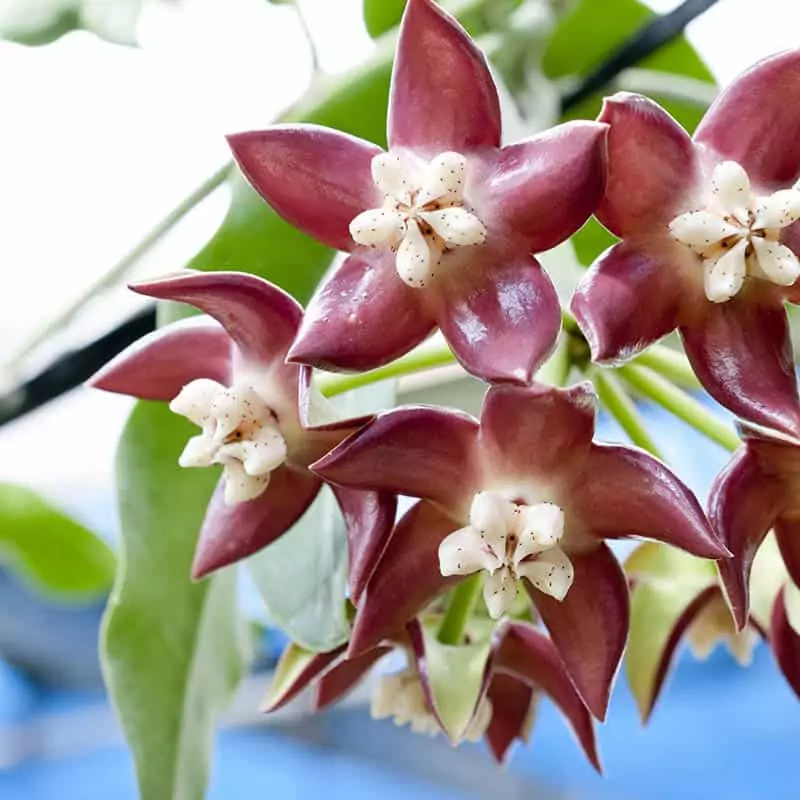
Hoya Imperialis has beautiful and large flowers and comes from Thailand. The plant is native to tropical areas and has extensive watering requirements. High humidity is also desirable, and the plant can tolerate a slight shade.
However, excellent drainage is a must, so the plant can handle a lot of moisture without rotting.
32. Hoya Skinneriana
Plant Hoya Skinneriana in well-draining soil. You can use perlite mix or coco peat to help the excess water drain. Skinneriana can survive under artificial lights and does best in bright and filtered light.
You can use it as a mounted plant, but the most beautiful Hoya Skinneriana looks like a hanging basket.
The beautiful pink flowers appear in late spring or early summer!
33. Hoya Diversifolia
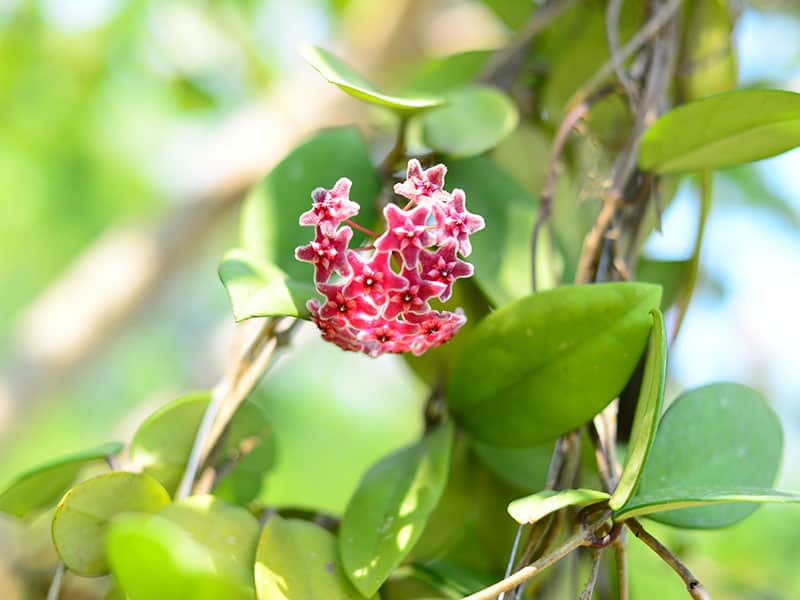
Hoya Diversifolia needs partial shade, even though it can survive in the heavy shade. The plant also needs wind protection and semi-warm temperatures. In the winter months, keep the Hoya Diversifolia dryer. But, ensure plenty of water in summer.
You can also use weak houseplant fertilizer during warm parts of the year.
34. Hoya Mindorensis
Hoya Mindorensis comes from the Philippines and might be slightly trickier to grow in standard indoor conditions. The plant doesn’t get overly happy in too hot conditions. Rather, it needs moderate temperature and plenty of bright light with little direct sunlight.
Standard Hoya Mindorensis develops red flowers, but some nurseries also carry lovely yellow and pink blooms.
35. Hoya Inconspicua
You can grow Hoya Inconspicua on a trellis or in a hanging basket. Inconspicua is native to the Solomon Islands and features mildly fragrant, small flowers.
Hoya Inconspicua is a fast grower, and once it starts blooming, it won’t stop for several months!
36. Hoya Limoniaca
Hoya Limoniaca is a compact vine with beautiful small white blooms! It grows best in filtered light or partial shade!
The blooming season starts in the early summer and lasts for several months!
You can grow it indoors and enjoy its beautiful fragrant flowers!
Hoya Limoniaca is a fast grower when you ensure ideal conditions!
37. Hoya Pauciflora
Hoya Pauciflora needs a lot of water during the actively growing season. It is a semi-succulent plant with fleshy and waxy leaves. Unlike other Hoyas, the Pauciflora grows only a few flowers.
The blooms disperse a lovely, sweet aroma and appear from spring to the beginning of fall.
Hoya Pauciflora looks best in hanging baskets!
38. Hoya Cinnamomifolia
Hoya Cinnamomifolia prefers standard succulent soil, and you can add perlite to improve drainage. The plant enjoys bright indirect light, and moderate to warm temperatures.
You can also keep the plant in a room with humidity over 60%.
Bright green flowers of Hoya Cinnamomifolia are scented, and appear in late spring.
39. Hoya Megalaster
Hoya Megalaster needs humidity over 60% in the actively growing season. Keep the plant under the medium sun and in well-draining, fertile soil. You can add perlite or sand to boost the drainage and nutritive value of the soil.
The plant needs warmth to thrive! In ideal conditions, the plant blooms with beautiful pink flowers. However, the flowers don’t last too long!
40. Hoya Fraterna
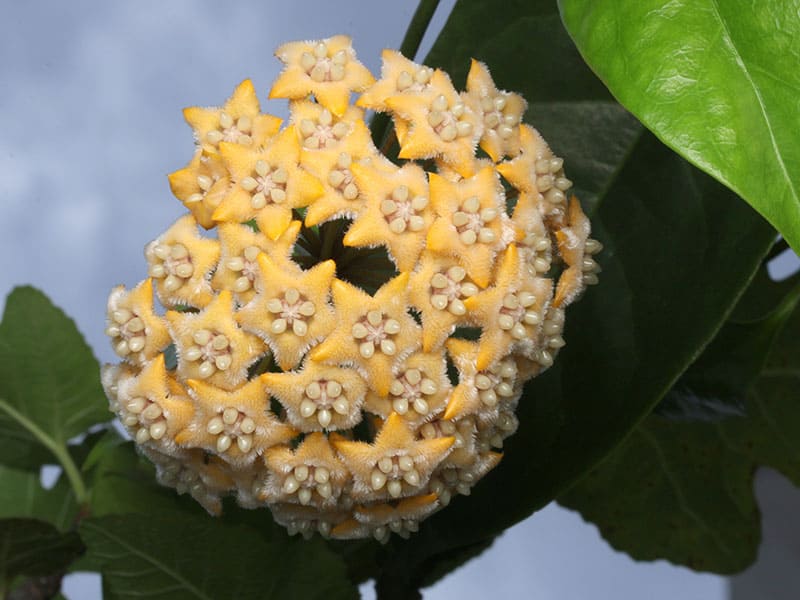
Hoya Fraterna is a fast-growing and fast flowering plant! It is also a beginner-friendly plant with dark green foliage.
The flowers are beautiful, salmon-colored, and last around five days. They have an interesting banana scent.
Fraterna is a low-maintenance plant. It can benefit from weak fertilizer in the spring.
41. Hoya Polyneura
Hoya Polyneura loves bright light and can benefit from slight exposure to direct sunlight. Unlike other Hoyas, the Polyneura doesn’t need a lot of water. It has watering requirements similar to most succulents.
Hoya Polyneura doesn’t need frequent repotting. You might need a bigger pot every two years!
42. Hoya Meliflua
Hoya Meliflua features lovely pink flowers with beautiful chestnut stains. The flowers are long-lasting and have a sweet chocolate-like aroma.
The blooming season starts in spring and lasts through mid-fall.
Meliflua isn’t a climber, like other plants. You can grow it in standard pots, like other indoor plants. Interestingly, Hoya Meliflua can tolerate slight coldness, but only for several days.
43. Hoya Krimson Queen
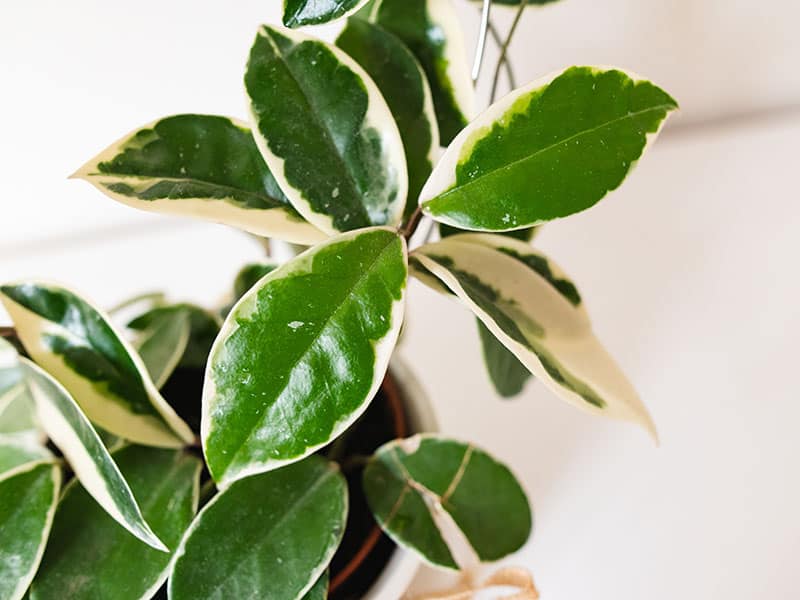
Hoya Krimson Queen thrives in a bright spot and warm temperatures. Let the soil dry between two waterings to prevent rotting and ensure optimal moisture.
The plant has an exotic look and low-maintenance nature. Once the new leaves appear, they are bright pink and slowly fade to green!
44. Hoya Bilobata
Hoya Bilobata is easy to grow, as long as you don’t let the soil dry completely between waterings. It is also one of the easiest Hoya varieties to propagate by stem cuttings. Air layering is also a great way to propagate this plant.
Hoya Bilobata is a very resilient plant and hard to kill. It isn’t prone to pests and diseases.
It has beautiful flowers which smell like honey!
45. Hoya Nicholsoniae
You can recognize Hoya Nicholsoniae by its green-yellow flowers. The plant is native to Australia and New Guinea and features spicy-scented blooms.
The scent becomes more intense when the sun goes down. Hoya Nicholsoniae is relatively easy to grow, and the growing requirements don’t differ from most other Hoya plants.
46. Hoya Finlaysonii
Hoya Finlaysonii is a wonderful tropical evergreen plant. Ensure well-draining soil, rich in organic matter to help your Finlaysonii plant develop to its full potential.
The plant is adaptable to various lighting conditions but grows best in a slight shade.
The plant is native to Malaysia and makes a beautiful indoor plant.
47. Hoya Affinis
If you are a true Hoya collector, you shouldn’t skip Hoya Affinis. It has the strongest fragrance of all Hoya plants! Also, the foliage has a somewhat waxy and fuzzy texture which makes an apparent contrast with large, red blooms!
Hoya Affinis is hard to kill, and a true beginner-friendly plant!
Tips for growing Hoya Affinis.
48. Hoya Albiflora
With its large and white blooms, Hoya Albiflora has a delicate charm. Albiflora is a popular climbing plant, which can climb up to eight feet.
It is a fast grower, with large and lush foliage and distinctive venation. The plant will develop showier blooms and healthier foliage when you use weak fertilizer in the growing season.
49. Hoya Archboldiana
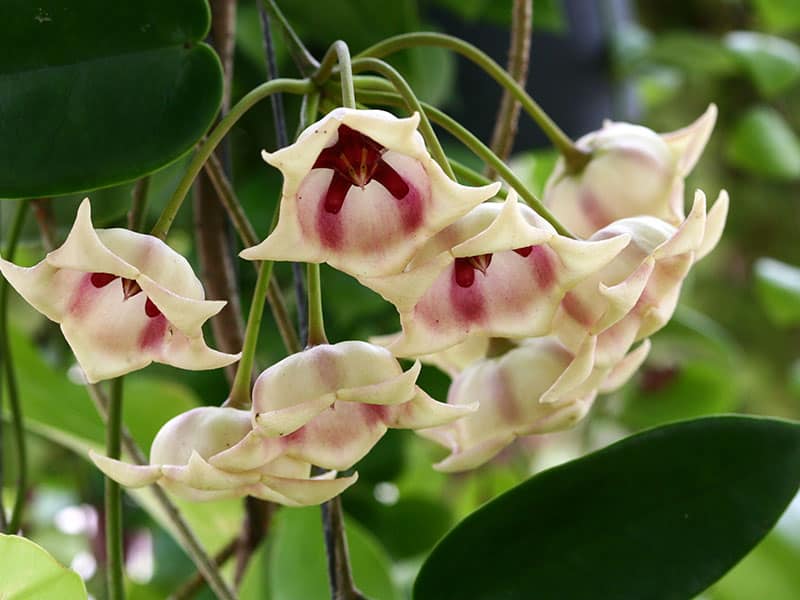
Hoya Archboldiana features robust and thick leaves with pointy edges. The variety isn’t very popular, but you can find it in some nurseries. It has large blooms in true-pink color with purplish centers.
The plant needs high humidity and a lot of sunlight to bloom. Luckily, it can grow under artificial lighting so it makes a great decorative houseplant!
50. Hoya Ciliata
Hoya Ciliata is a tropical plant, native to Indonesia and the Mediterranean region.
The plant has attractive, black flowers with yellow tops and the distinctive aroma of peanut butter!
The ideal growing conditions for Hoya Ciliata are temperatures between 65 and 80 degrees Fahrenheit.
51. Hoya Darwinii
Hoya Darwinii has interesting dimorphic foliage with not very noticeable veins. Flowers’ color varies from light salmon to bright pink or white with rose pink centers.
Sap can be toxic to children and animals and can cause skin irritations. You can propagate Hoya Darwinii via stem cuttings!
52. Hoya Imbricata
Hoya Imbricata is sensitive to water-clogged soil. The plant needs a lot of water, but only if the soil is well-draining. In ideal conditions, Hoya Imbricata features a moderate to fast growth rate.
The thin and long vines develop in high humidity, and the plant needs sunlight to bloom! So, your plant will need sufficient support!
Boost the growth of Hoya Imbricata.
53. Hoya Multiflora Albomarginata
Hoya Multiflora Albomarginata is a collectors’ favorite plant that looks great in a standard pot or hanging baskets! Keep it away from direct sunlight, as it can cause stunted growth or burn the leaves.
The leaves are slightly variegated with different shades of green and yellow. Albomarginata is one of the hardest houseplants to kill, enjoys moderate sun exposure and moisture abundance!
54. Hoya Curtisii
Hoya Curtisii is a Hoya plant more suitable for small spaces. It has beautiful small, spade-shaped foliage.
The plant is native to hot and humid forests, but it can tolerate a slight dryer environment.
It grows best when you place it in front of a sunny window and ensures the plant gets a few hours of direct sunlight!
Find out what is wrong with Hoya.
55. Hoya Excavata
Hoya Excavata features rigid stems and vigorous climbing nature. The plant is native to Indonesia and easy to propagate by stem cuttings.
It thrives in a hot and humid environment and doesn’t like too much sunlight. A slight shade is great for Hoya Excavata!
You can grow it in pots with excellent-drained soil!
56. Hoya Guppyi
Hoya Guppyi is a rare Hoya variety with elegant pink and yellow blooms. This exotic plant isn’t prone to pests and disease and is relatively low-maintenance.
However, sometimes leaves can get damaged from fungal diseases. Don’t overwater the plant to prevent fungal disease and rotting.
57. Hoya Macgillivrayi
You can grow Hoya Macgillivrayi outdoors during warm months. But ensure the plant stays protected when the temperatures drop. It features unique dark purple blooms and beautifully glossy, dark-green foliage.
The plant can get very tall and needs sturdy support.
Hoya – Exotic Plant For Every Living Room
As you can see, the Hoya plant is such a rewarding plant. Expect exceptional results and a true exotic gem in your home with minimal effort!
My favorites are Hoya Ciliata and Hoya Imperialis. What about you? Which Hoya is the first on your wish list?
If you enjoyed the article, please share it with like-minded friends and family to spread the word about lovely Hoya plants!
